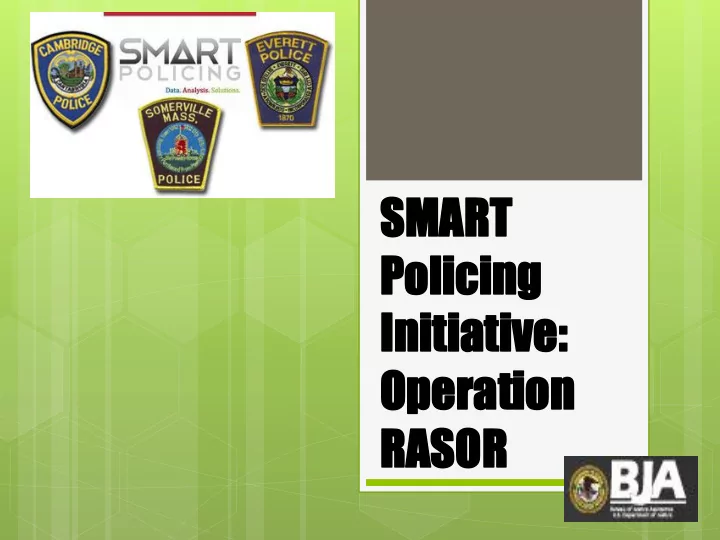

SM SMART ART Po Policing icing In Initiative: tiative: Oper eration tion RA RASO SOR
Operation RASOR Overview Intros • Cambridge, Everett, and Somerville • Mission, Goals, and Governance Structure • 15 Good Minutes: Collaboration and Capacity Building • Regional Analysis: Impact Players • Field Interviews and Observations • 5 good minutes: Evaluation • Where Do We Go From Here? •
Operation RASOR Operation RASOR Regional Analysis for the Safety of Our Residents Cambridge Everett Somerville
Operation RASOR Strategic Plan: Mission Statement The Smart Policing Initiative will prevent crime by establishing a collaborative partnership between the Cambridge, Everett, and Somerville police departments and a research partner, to build a regional capacity to use advanced predictive analytics and evidence-based practices.
Operation RASOR Strategic Plan: Governance Steering Committee Project Management Team Information Data & Analytics Tactical & Technology / Research Operations Subcommittee Subcommittee Subcommittee
Operation RASOR Goal 1: Reduce Crime & Improve Safety Reduce crime and Focus on chronic improve safety by locations and developing impact players preventive Measure crime strategies based reduction on actionable data produced by crime analysts and technology that uses predictive analytics.
Operation RASOR Goal 2: Collaboration Develop and put into operation an active and participative collaboration among three police agencies and the research partner to establish Predictive Policing Measures: Face-to-face meetings (25 times over the last year), formal conference calls (24 times), and other contacts via email (475 times)
Operation RASOR Goal 3: Capacity Building Develop and build capacity for using Predictive Policing and Smart Policing and develop methods to sustain Predictive Policing after the grant ends. Measures: trainings, knowledge building (reading material), discussions of innovative responses to address crime problems; surveys; qualitative methods (observations).
Operation RASOR Goal 4: Regional Analysis Increase efficiency of crime analysts, police officers, and investigators by developing regional standards and systematic practices to perform analysis using new and innovative technology Measures: creation of regional databases; new technologies, training sessions
Operation RASOR Goal 5: Problem Solving Utilize analysis and problem solving to implement innovative interventions to improve neighborhood safety. Measures: strategies, use of analysis, responses, assessments
Operation RASOR Goal 6: Predictive Analytics Develop innovative predictive analytic tools Measures: training on predictive analysis; partnerships with MIT established to develop useful analytics
Operation RASOR Goal 7: Inclusion Include other agencies in the Boston area to develop and implement Predictive Policing and Smart Policing Methods Measures: # of partnerships (12 other agencies outside of our grant); 8 organizations have sought participation with us
Operation RASOR Goal 8: Evaluation Evaluate the effectiveness of the interventions through rigorous methods. JSS documents progress to date (process evaluation) Outcome evaluation will be developed as interventions are designed and implemented
Operation RASOR 15 Good Minutes: Collaboration and Capacity Building What does it take to collaborate across jurisdictions? What are the challenges? How do we build regional capacity for data collection, crime analysis, and implementation of effective crime reduction strategies?
Operation RASOR 15 Good Minutes: Regional Analysis How do we identify impact players across three jurisdictions? How do we identify chronic locations across three jurisdictions?
Operation RASOR 15 Good Minutes: Regional Analysis and Crime Database Cambridge High- RMS Risk Offend Everett Regional er List RMS Database Somerville RMS
Operation RASOR Development of Impact Player Profile Templates:
Operation RASOR Challenges: How do we define “Impact Player”? Multi-jurisdictional challenges Differences in RMS, data availability, and crime classification across three jurisdictions Lack of crossover of offender activity (most activity is within one city or a crossover between two cities, not across all three). Cambridge & Everett don’t share a border.
Operation RASOR Challenges: Database is top heavy with homeless, not the offenders that most would consider high risk or “impact” players. Need to examine incident weights. Data are static, not continuously updating. How do we keep info current? How do we handle and include confidential info (informants, ongoing murder investigations, etc.)? How do we account for data errors in incident reports (unknown SPs, misspelled names/DOBs, etc.)? How do we balance our time? How much time/work it will take to keep intel database up-to-date once started
Operation RASOR 15 good minutes: Field Interviews Officers from 3 PDs developed an FIOS policy that was then vetted by the CPD Legal Advisor Officers developed training on the policy in collaboration with the Legal Advisor The FIOS policy will build capacity in each agency and across jurisdictions for regional analysis
Operation RASOR 5 Good Minutes: Evaluation Process evaluation: What was planned? What was implemented? Were the goals met? Impact evaluation: What was the impact on crime? What was the impact on the community? On police?
Operation RASOR 5 Good Minutes: Where do we go from here? Develop and implement interventions focused on problem people Conduct regional analysis of problem places and problem crimes Continue to develop more advanced analytics & models incorporating research findings Expand collaboration to other police departments
Operation RASOR Where do we go from here? Continue training on analysis and problem solving (POP Conference) FIOS Training through November across jurisdictions FIOS Implementation Identify chronic locations Develop problem solving strategies for location-based efforts
Operation RASOR Questions?
Recommend
More recommend